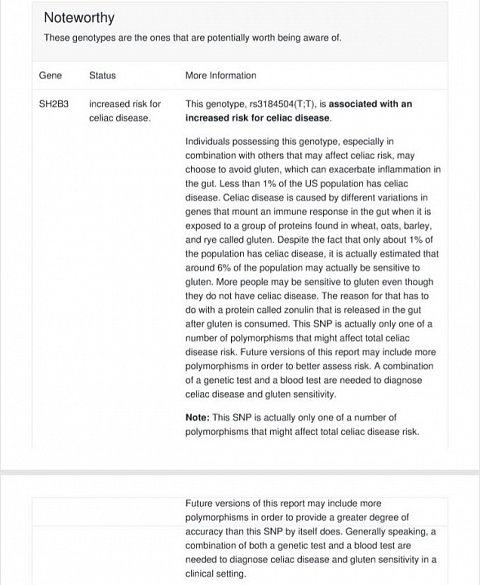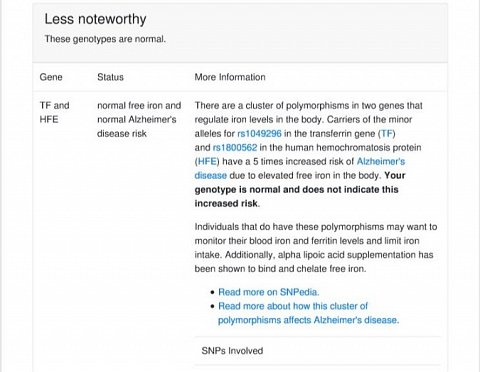-
Comprehensive Report
review on May 18, 2018
by Rebecca Fishwick

At a Glance
Summary
The information included in my report was comprehensive, with plenty of references to the particular genes and variants in my genome, as well as links to research. I felt that Dr. Rhonda Patrick, who authored the report, had good credentials and an obvious wealth of knowledge, which was apparent from her many podcasts and videos about genetics. While the language in the reports was fairly science-laden, it was still possible for a layman to extract information from them. For a pay-what-you-can service, I felt that the information given was both generous and reliable.
Full Review
FoundMyFitness was created by Dr. Rhonda Patrick, who, in addition to her Ph.D. in biomedical science from the University of Tennessee, trained as a postdoctoral fellow at Children’s Hospital Oakland Research Institute. Dr. Patrick has conducted research into and published articles on metabolism, inflammation, DNA damage, aging, cancer, and nutrition.
Product Expectations
The FoundMyFitness website was sleek, with a slightly clinical feel. A large amount of what Dr. Rhonda Patrick did seemed to consist of teaching others about genetics, since the site contained a number of videos, podcasts, and articles. There were links to subscribe to her YouTube channel and podcast on iTunes, and links to the FoundMyFitness social media channels.
The FoundMyFitness health reports, while technically free, were a pay-what-you-can service, with a recommended donation of $10 for the most comprehensive report. The site also had links to Patreon and FoundMyFitness’ own subscription service, where users could donate a monthly amount or make a one-time donation. The website was supported entirely by donations, and donors could receive perks such as early access to updates.
Clicking on “Genetics”, I learned that the genetic report would tell me more about how my genetic variants might affect the way my body absorbs, metabolizes and utilizes nutrients, and how effectively my body eliminates foreign substances and carcinogens. Combined with environmental factors, these variants may impact my disease risk and longevity.
The “Genetics” page included an FAQs section, where I learned that though my report would be fairly accurate, its true accuracy may be decreased due to reliance on scientific studies that don’t account for medical history or environmental, dietary, microbial or lifestyle factors. These factors can alter the actual risk of developing a trait or disease.
I also read that my report would explain the function of each gene included, how my genotype might affect the gene’s function, and how this could affect my risk of disease. It would also suggest nutritional and lifestyle changes I could make depending on my genotype that had been scientifically linked to lowering disease risk. (This did not constitute medical advice.)
I read that the report had been tailored by Dr. Patrick to focus on the genes that are of the most consequence in terms of health, and would be revised and updated periodically. My report would be valid for 30 days.
In the information for the Comprehensive Report, I saw that it included the genetic variants used in all other reports (the ‘APOE Genotype’ report and ‘PPAR Genotypes’ report). I would learn about the variants and polymorphisms involved in the metabolism of vitamin D and omega-3 fatty acids, vitamin B12 absorption, the metabolism and excretion of potentially harmful compounds and carcinogens, saturated fat metabolism, and my genetic risk of heart disease.
Ordering Experience
In order to access the Comprehensive Report, I first had to create a FoundMyFitness account. This required me to enter a username, email address, and password. I was then sent an email to confirm my account, which I had to do in order to access the genetic reports. I could also select how often I’d like to receive community and news email updates from FoundMyFitness. (“Never” was an option.)
I could now connect with my 23andMe account: the only sort of DNA data the site was currently accepting. Clicking on “Connect with 23andMe” brought me to a page where I had to enter the email and password I’d used to register with 23andMe. I was then asked for permission for 23andMe to grant access to FoundMyFitness. This would allow FoundMyFitness to read my genomic data, the full name on my account, my email address, and my 23andMe profile’s service type (i.e. ancestry or health and ancestry).
While on the FoundMyFitness website, I hadn’t seen any links to a Terms and Conditions page or Privacy Policy, and so I didn’t know how secure my data would be once I shared it with FoundMyFitness. Still, it seemed a reputable site with good credentials, and so I went ahead and granted access.
It was only when I went to run the Comprehensive Report that I was presented with the Terms of Service, which I had to accept in order to run the report. Here, I read that by using a third party genetic tool (i.e. FoundMyFitness), I would be adding another layer susceptible to error, meaning that any inaccuracies in the report would only be added to any inaccuracies already in my raw data.
By accepting the Terms of Service, I was acknowledging this, and also that any information in the report would need to be independently verified, and that I was “strongly encouraged” to discuss this information with a qualified professional. I would also agree to “indemnify” (i.e. compensate) and hold harmless 23andMe, FoundMyFitness and other FoundMyFitness related entities for any and all damages arising from the use of the website.
After accepting the Terms of Service, I was able to access my report pretty much immediately, and was prompted for a donation.
The Results
I could view the report online (where it would be available for 30 days), or on a PDF file that was promptly emailed to my account.
Results Section: Comprehensive Report – Noteworthy Genes
On opening the PDF file, I was presented with a table showing a selection of my health-related genetic variants. This included details of what each particular gene’s function was, which genetic variant I had, and how my variant affected gene function (shown below).

A section of the noteworthy genes in my Comprehensive Report.
The genotypes that were considered noteworthy were listed first. In the example in the image above, I was told that my version of the SH2B3 gene was associated with a higher risk of celiac disease, which causes gluten intolerance. I was given a reference of my particular genetic variant (rs3184504), and I was told my genotype was T;T. There was a link to read more on SNPedia.
I don’t have celiac disease, as far as I know. Given my genotype, I supposed there was a chance I might yet develop it. Still, I read that this variant was not the only genetic factor that might increase the risk of celiac disease. And since I’d been told that the report wasn’t 100% accurate and not medical advice, I decided not to dwell on it.
Other noteworthy genetic variants I had included the variant in my GSTP1 gene, which meant that vitamin E may have a harmful effect on me. I also had the version of the FTO gene associated with a 1.7-fold increase in obesity risk, due to the negative effect of saturated fat on my blood glucose and insulin levels. I also discovered I had a genetic risk for vitamin D deficiency, which may mean I have a shorter lifespan and higher “all-cause” mortality (which I took to mean that literally anything could kill me).
I found that certain genes, such as FTO, were listed multiple times. This was a bit confusing, as at first I thought I was being shown the same information over again. I realized that the reason for this was that I had multiple variants within the same gene (i.e. more than one of the alleles that made up the gene had mutated). Unfortunately, not one of my mutations within the FTO gene was good news, since they gave me an increased risk of obesity and type-2 diabetes.
Results Section: Comprehensive Report – Less Noteworthy Genes
I actually preferred reading about my “Less noteworthy” genetic variants, since it was a lot less bleak.

A section of my less noteworthy genes.
For instance, my copies of the TF and HFE genes (shown in the above image) gave me normal genetic iron levels, and did not increase my risk of developing Alzheimer’s.
I also found that one variant in my CYP2R1 gene gave me no risk of vitamin D deficiency, though in the “noteworthy” section, I’d found I had another variant in the same gene that gave me an increased risk of vitamin D deficiency. But I supposed the two evened out.
My copy of the PPAR alpha gene predisposed me to normal fat metabolism, which was nice since I hoped it would lessen the risk shown in my other results, which suggested I had a higher predisposition to obesity.
Summary
The information included in my report was comprehensive, with plenty of references to the particular genes and variants in my genome, as well as links to research. I felt that Dr. Rhonda Patrick, who authored the report, had good credentials and an obvious wealth of knowledge, which was apparent from her many podcasts and videos about genetics. While the language in the reports was fairly science-laden, it was still possible for a layman to extract information from them. For a pay-what-you-can service, I felt that the information given was both generous and reliable.


